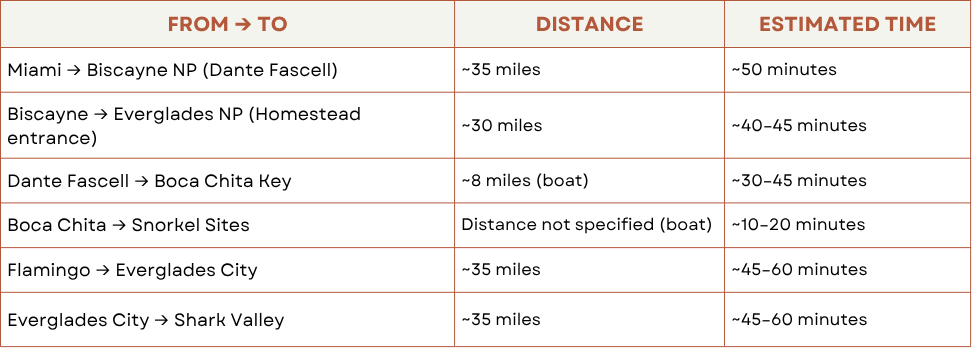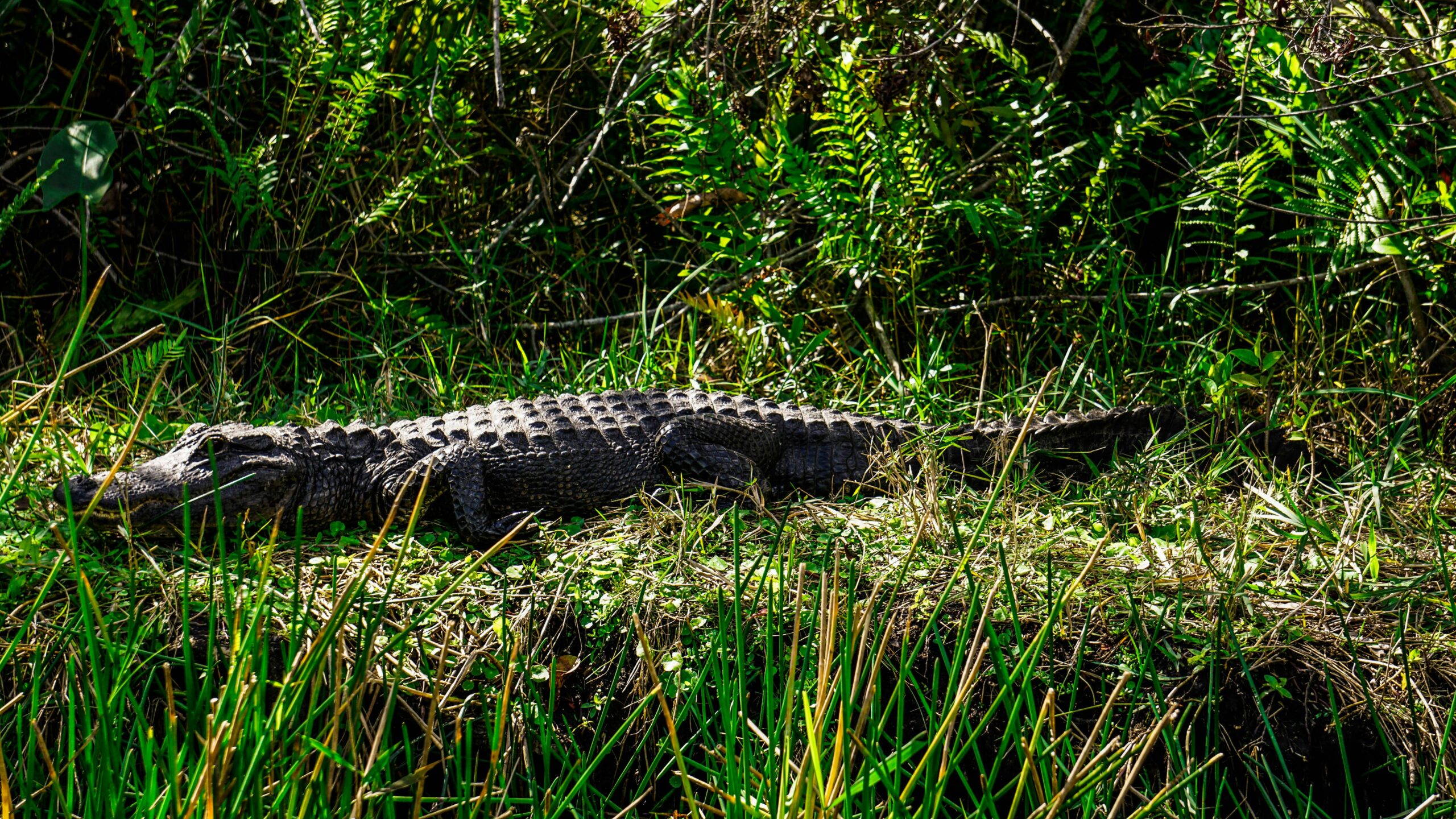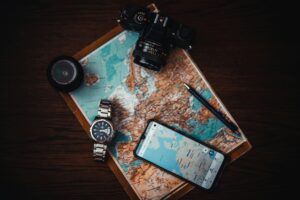Get ready for a South Florida adventure where you jump from sawgrass fields to sparkling blue bays. Biscayne National Park and Everglades National Park are only about 30 miles apart, making it easy to explore both on a single trip. You can paddle through quiet mangroves, watch for dolphins and manatees, walk boardwalks over swamps, and snorkel above bright coral reefs—all in just a few days.
With this detailed day-by-day itinerary, you’ll see the best of both parks, from hidden alligator spots to the islands off Miami’s coast. Whether you want to hike, kayak, snorkel, or spot wildlife, there’s a perfect stop for every interest. Driving time between the parks is about 40–45 minutes, so you won’t spend more time in the car than out in nature.
Pack your camera and some sunscreen—you’re about to discover two of Florida’s most beautiful wild places.
Scroll down to the end for travel times, distances, and key activities by day.
Essential Trip Planning and Logistics
Your Biscayne and Everglades adventure depends on timing, transportation, and packing smart. Miami is your main hub, and you’ll spend a lot of time outdoors—so how, when, and what you prep really matters.
Best Time to Visit and Seasonal Tips
Winter and spring (December through April) are the best times to visit. This is the “dry season,” so you’ll see fewer mosquitoes, less rain, and cooler temperatures. Daytime highs are usually in the 70s to mid-80s °F, which is perfect for hiking, paddling, and snorkeling.
Summer brings heat, humidity, and afternoon thunderstorms. Mosquitoes can be fierce, especially in the Everglades, so plan outdoor activities early in the day if you visit between May and November. The hurricane season runs from June to November, so always check the forecast and park websites for weather alerts.
Park facilities, visitor centers, and ranger programs are more frequent and reliable during the busy winter months. Some areas or tours might close or run less often during the wet season.
Transportation Options from Miami

Miami is about 40 minutes (30 miles) from Everglades National Park’s Homestead entrance and roughly the same distance to Biscayne National Park’s Dante Fascell Visitor Center. Renting a car is your best bet since there’s no direct public transit to many park entrances or boat tours.
If you do not drive, some companies offer day tours from Miami that include transportation, but these can be limited and may not allow you as much flexibility. Taxis, rideshares, or shuttles could get you as far as Homestead, but to reach sites like the Shark Valley Visitor Center or Biscayne boat launches, you’ll usually need your own vehicle.
Keep in mind parking is available at major visitor centers but can fill up during busy weekends and holidays.
Recommended Packing List and Gear
Bring lightweight, long-sleeve shirts, quick-dry shorts or pants, and a wide-brimmed hat for sun protection. A sturdy pair of walking shoes or hiking sandals is a must for trails, while old sneakers or water shoes are perfect for paddling or slogging through wetlands.
Pack insect repellent (especially for the Everglades), reef-safe sunscreen (to protect you and the coral), sunglasses, and a reusable water bottle. Don’t forget a waterproof phone case or dry bag for boat trips, and a small daypack for snacks and extra layers.
Carry your photo ID, park passes (if bought in advance), and a copy or screenshot of your reservations for guided tours or boat rentals. Binoculars and a camera will also come in handy for spotting wildlife from trails and observation towers.
Day 1: Gateway to Biscayne – Visitor Center and Mangrove Exploration
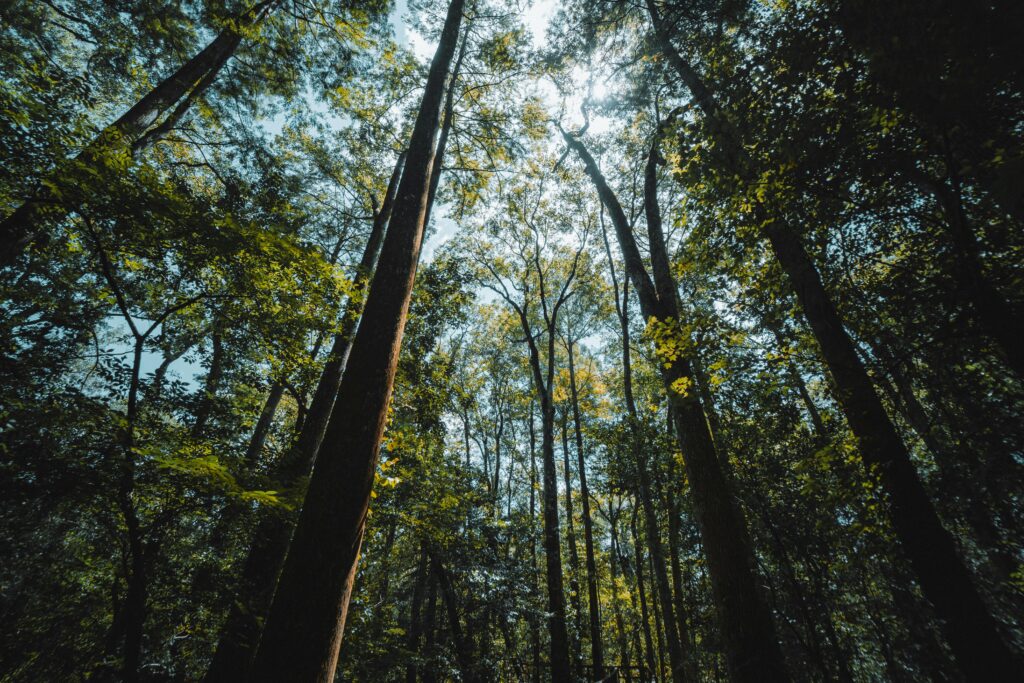
Kick off your adventure at Biscayne National Park, home to bright blue waters, thick mangrove forests, and a huge variety of animals. You’ll start exploring from land and see how the coast and mangroves shape everything you do here.
Start at Dante Fascell Visitor Center
Your day begins at the Dante Fascell Visitor Center, located about 50 minutes (35 miles) south of downtown Miami by car. The center sits right at the edge of Biscayne Bay, so as soon as you arrive, you get great views of the water.
Inside, you’ll find interactive exhibits about the park’s history and ecosystems, including stories on the Tequesta people—the area’s first inhabitants. There’s a short film, big wall maps, and helpful rangers who can give you tips for your visit.
Before heading outside, grab a park brochure and check on any ranger-led programs. Restrooms, shaded picnic tables, and a gift shop are all here, so it’s a good spot to get organized before heading out on trails.
Walking the Mangrove Forest Trails
From the visitor center, step onto the Biscayne Nature Trail, an easy loop of about 1.2 miles. The walk takes you through dense stands of red, white, and black mangroves. Raised boardwalks keep your feet dry and give you great views, especially at high tide.
As you walk, you’ll see tangled roots dipping into the water—look for tiny crabs and small fish darting among the roots. Mangroves in this park give shelter to countless creatures and help protect the coast from storms.
The trail is flat and well marked, so it’s family-friendly and doesn’t require hiking gear. Give yourself 45–60 minutes to explore at a relaxed pace.
Wildlife Watching Along the Coast
The edge of Biscayne Bay is a hotspot for all kinds of wildlife. Bring binoculars if you can—over 300 bird species have been recorded in the park, including brown pelicans, ospreys, and herons.
If you’re lucky and patient, you might spot manatees gliding near the shoreline or dolphins playing farther out. Early morning or late afternoon are best for animal sightings, when the park is quieter and wildlife is more active.
There are benches along the water for sitting and watching, and signs help you ID what you see. Don’t forget sunscreen and water—it gets sunny and humid even near the coast.
Day 2: Islands, Lighthouses, and Marine Heritage
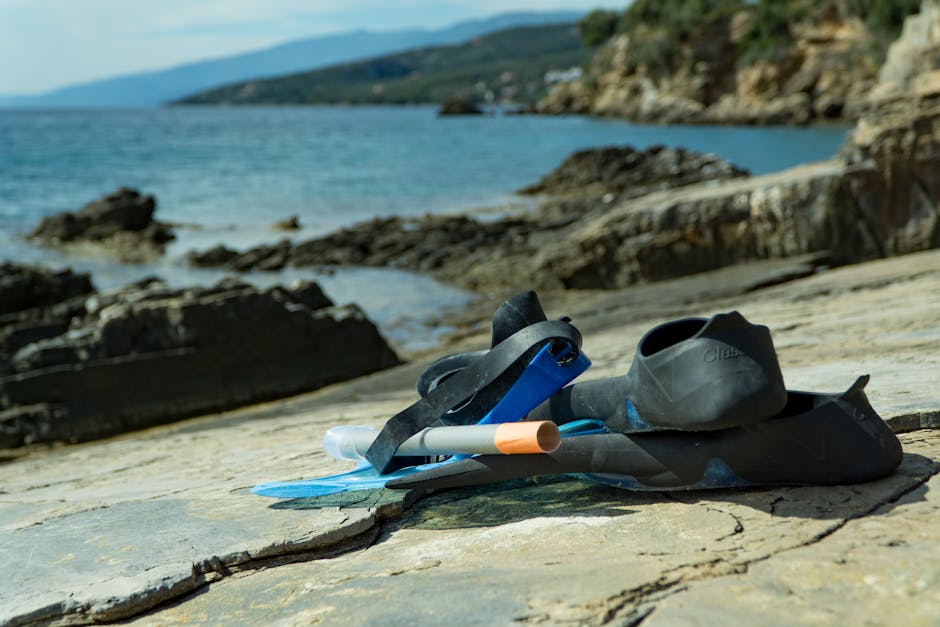
Today is all about exploring Biscayne National Park’s islands and the stories beneath its waters. You’ll travel by boat, visit a historic lighthouse, and discover shipwrecks along a famous trail.
Boating to Elliott Key and Boca Chita Key
Start your morning at the Dante Fascell Visitor Center. From here, arrange a boat tour or rent a boat to reach Elliott Key and Boca Chita Key. The boat ride to either island takes about 30-45 minutes (about 9 miles to Elliott Key and about 8 miles to Boca Chita Key).
Elliott Key is the largest island in the park. Here you can walk nature trails, go swimming, and have a picnic by the shoreline. If you want, you can camp overnight—the campground has basic amenities like toilets and picnic tables.
Boca Chita Key is smaller but has a beautiful grassy picnic area. Boats dock right at the island. Expect clear views of the bay and opportunities for birdwatching. Morning hours tend to be quieter and less crowded.
Visit the Boca Chita Lighthouse
The highlight of Boca Chita Key is the Boca Chita Lighthouse. Climb the spiral stairs for a wide view of Biscayne Bay and the Miami skyline. The opening hours of the lighthouse can change, so check with a park ranger upon arrival.
This lighthouse was built for decoration in the 1930s but is now a well-known site in the park. It’s a great spot for photos and spotting boats passing through the bay.
There’s a picnic area near the lighthouse where you can relax, have lunch, and watch the water. Restrooms and shaded areas are nearby. Kids can explore safely, and there’s plenty of space to stretch out.
Maritime Heritage Trail and Shipwrecks
After lunch, take a guided snorkeling tour along the Maritime Heritage Trail. Biscayne’s Maritime Heritage Trail is famous for its underwater shipwrecks. You’ll visit sites like the Mandalay, a well-preserved steel-hulled schooner.
Most shipwrecks are in shallow water (10 to 25 feet deep), so beginners can join in. Guides provide strong safety tips and gear for everyone. Expect to see schools of fish, colorful corals, and sometimes even sea turtles.
You’ll travel between sites by boat, with rides from Boca Chita or Elliott Key taking 10-20 minutes. The underwater trail brings the park’s history to life, letting you see what makes Biscayne’s marine environment so unique.
Day 3: Underwater Adventures – Coral Reefs and Marine Life
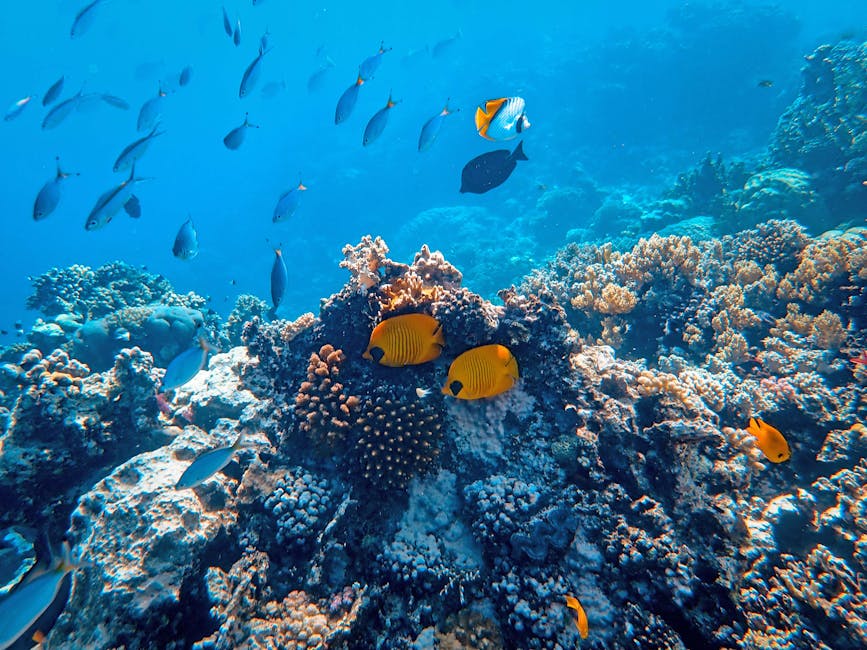
Today is all about exploring Biscayne’s famous underwater world. Jump into crystal-clear water and come face-to-face with vibrant coral reefs, sea turtles, and countless fish.
Snorkeling Tours and Kayaking
Start the morning at the Dante Fascell Visitor Center. From here, guided snorkeling tours and kayak trips leave for the best reef spots. Most tours last about 3 to 4 hours.
The boat rides to the reefs take 30 to 45 minutes, covering about 7 to 10 miles offshore. Guides will help you with equipment and explain safety rules. If you prefer, rent a kayak and stick closer to the mangroves, where shallow water is home to tons of small fish and maybe even juvenile sea turtles.
On windy days, boats may only visit the nearer reefs or sheltered mangroves, but you’ll still have plenty to see. Tours often include time to relax on the boat between dips in the water. If you plan ahead, you can visit Fowey Rocks, a reef and lighthouse area known for clear views and colorful marine life.
Tip: Bring reef-safe sunscreen, a towel, and plenty of water. Snorkel vests are usually supplied and required.
Exploring Coral Reefs and Spotting Sea Turtles
The coral reefs south of Elliott Key are some of the healthiest and most colorful in the park. At spots like Anniversary Reef and Ball Buoy Reef, you’ll see coral formations just a few feet below the ocean’s surface.
You’re likely to spot sea turtles gliding gracefully among the corals. Green and loggerhead turtles are the most common here. Sea grass beds near the reefs give these turtles a place to feed.
The reefs are also home to hard and soft corals, sponges, and even lobster hiding under ledges. If you’re really lucky, you might catch a glimpse of a gentle manatee moving near the channels.
Always keep a safe distance from wildlife. Use slow, calm movements so you don’t scare away the turtles or damage the fragile corals.
Colorful Fish, Dolphins, and Other Marine Wildlife
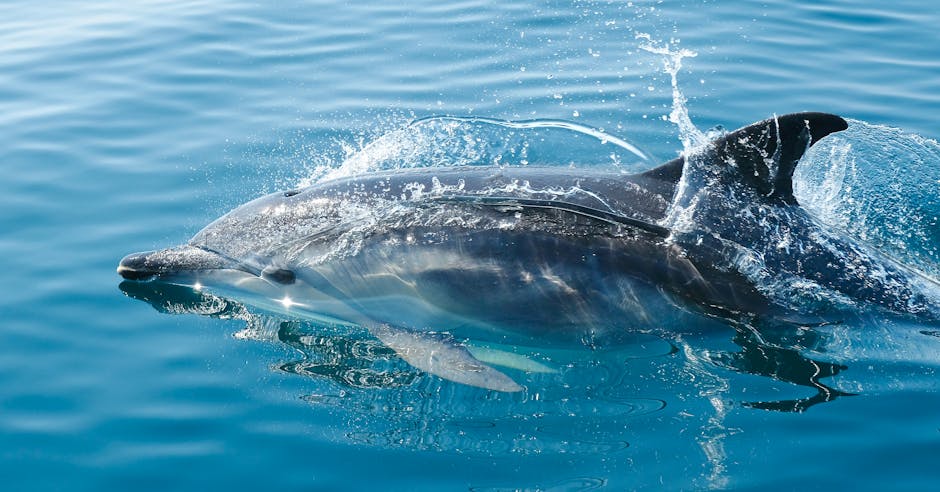
Snorkeling Biscayne means swimming among schools of tropical fish. You’ll likely see parrotfish, angelfish, sergeant majors, blue tangs, and snappers in every direction.
Look for trumpetfish camouflaged close to the reefs, or barracudas hovering in the open water. Nurse sharks and lobsters sometimes rest under rocks and ledges.
If you scan the open sea, you might spot playful dolphins cruising by the boat. On calm days, keep an eye out for the smooth back of a manatee near the mangroves.
For a quick reference, here’s what you might see:

Take time to float quietly and watch this underwater world in action. There’s something new every few feet.
Day 4: Camping, Ranger Programs, and Everglades Excursion
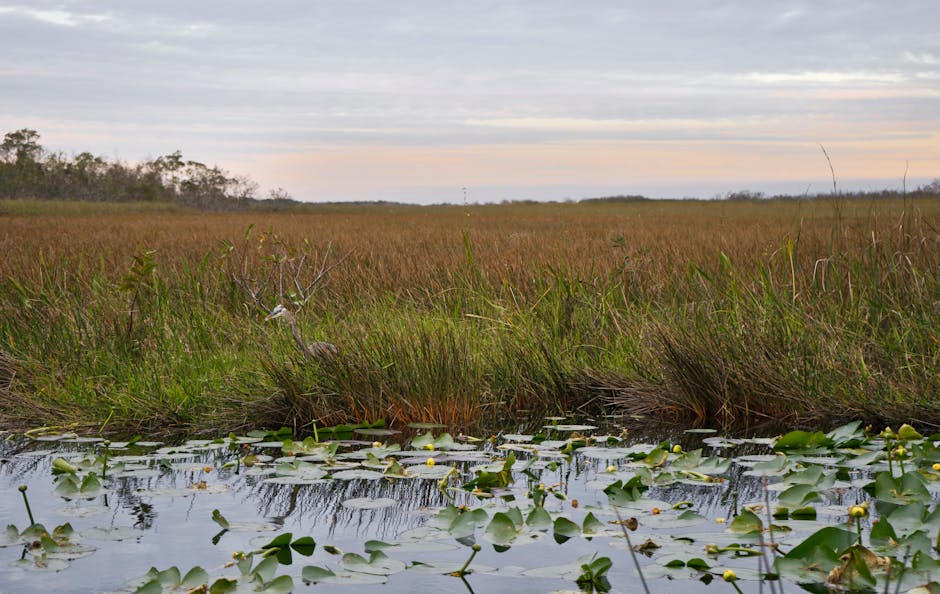
Wake up surrounded by nature and get ready for a day that blends outdoor living, learning, and adventure. Today, you’ll camp among the islands, join fun ranger-led activities, and venture deep into the wild heart of the Everglades.
Camping Options Among the Keys
Set up your tent at one of the campgrounds near the water, like those found in the Flamingo area or on some of the small islands (known as keys) within Biscayne National Park. The distances within the park are pretty short; you can reach most campgrounds with a boat or kayak trip of under 5 miles, which often takes less than two hours.
Basic amenities like restrooms and picnic tables are available at larger sites, such as Flamingo Campground. For a back-to-basics experience, try island camping on Elliott Key or Boca Chita Key. These island sites come with incredible sunrise views and star-filled nights. Reservations might be needed, especially during busy months, and you’ll want to pack food, water, and bug spray.
Ranger-Led Programs and Educational Activities
Dive into a ranger-led program to get more out of your visit. These can include guided paddles, boat tours, or even astronomy nights in the Everglades. Programs often last 1–3 hours and start from main visitor centers like Dante Fascell in Biscayne or the Flamingo and Gulf Coast centers in Everglades National Park.
Rangers explain the local wildlife, from manatees to roseate spoonbills soaring overhead. Join a “Paddle with a Ranger” event to explore mangroves up close or take a boat tour to spot dolphins and learn about coral reefs. Check schedules ahead of time, since some programs run only on certain days or seasons.
Extend Your Trip: Exploring the Everglades
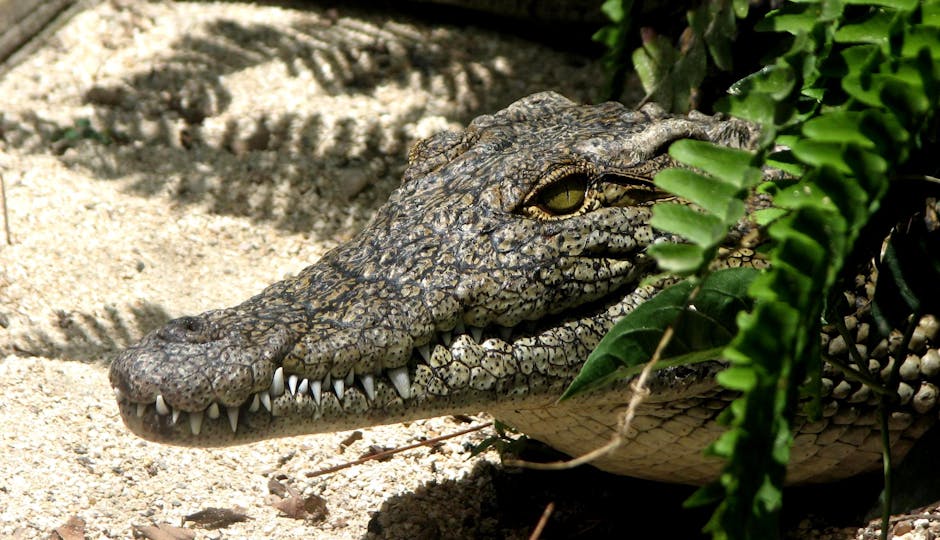
If you’re not quite ready to leave, extend your trip with a full Everglades day. From Flamingo, drive or paddle northwest about 45–60 minutes (around 35 miles by car) to the Gulf Coast side near Everglades City for a change in scenery.
From here, you can join a guided kayak tour into the maze of mangroves or a wildlife boat trip. Watch for alligators, turtles, and more wading birds along the water’s edge. Trails and boardwalks like Anhinga Trail or the raised walk at Shark Valley (both within an hour’s drive) offer easy hikes with plenty of chances for photos and close-up wildlife views.
Conservation, Safety, and Final Travel Tips
It’s important to keep Biscayne and the Everglades beautiful and healthy by following a few easy practices. You’ll also make your visit safer and more enjoyable if you’re prepared and mindful.
Protecting Wildlife and Habitats
Biscayne and the Everglades are home to manatees, sea turtles, dolphins, gators, and hundreds of fish and bird species. Avoid feeding or touching all wildlife—this protects both you and the animals.
Stick to listed trails and boardwalks to prevent trampling sensitive habitats like mangroves and nesting grounds. Use reef-safe sunscreen to prevent harmful chemicals from washing into the water and damaging coral reefs. Whenever you’re near the water, look out for seagrass beds and coral—don’t anchor your boat on them or stand on coral while snorkeling.
Pack out all your trash to prevent wildlife from eating or becoming trapped in it. Respect quiet areas where birds are nesting.
Responsible Recreation and Leave No Trace
Follow Leave No Trace guidelines, especially when camping, hiking, or boating. Take everything you brought with you, including food wrappers and bottles, and dispose of trash in marked bins.
Wear insect repellent if you visit in the summer, but pick lotions over sprays to avoid contaminating the water. When swimming, never touch marine life or lift animals out of the water—observe only.
If snorkeling or diving, don’t stand on, touch, or take pieces of coral, shells, or plants. Use marked boat ramps and observe speed zones to avoid hitting marine animals.
Pack reusable water bottles and snacks to cut down on plastic waste. If you fish, know all the park regulations and respect protected areas.
Summary of Distances and Estimated Travel Times
Here’s a quick guide for your trip:
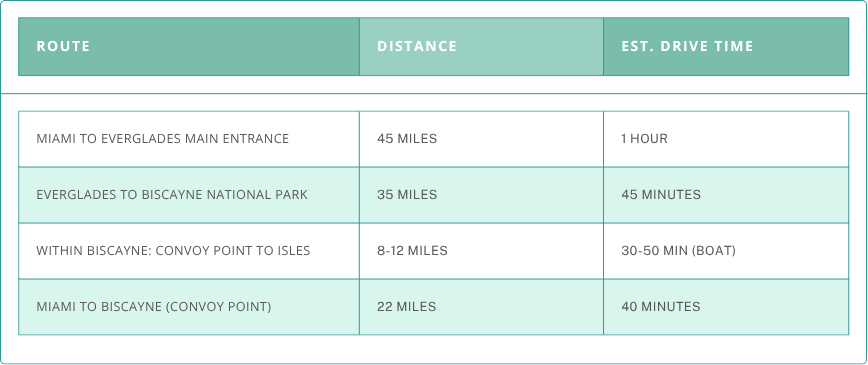
Travel times may shift based on traffic or weather, especially in the park. Most roads are flat and easy to navigate, but boat excursions depend on the operator and conditions on the water. Plan extra time for parking, getting on boats, and winding roads inside the parks.
Biscayne and the Everglades – Quick Itinerary Summary
🗓️ Day 1 – Biscayne Bay & Mangrove Trails
- Base: Dante Fascell Visitor Center, Biscayne National Park
- Drive from Miami: ~50 minutes / ~35 miles
- Activities:
- Visit Visitor Center exhibits and film (1–1.5 hours)
- Walk the Biscayne Nature Trail (1.2 miles, ~45–60 mins)
- Wildlife viewing along the coast (1–2 hours)
- Total Time Estimate: 4–5 hours
- Highlights: Mangrove forests, crabs, birds, possible manatees/dolphins
🗓️ Day 2 – Island Hopping & Shipwreck Snorkeling
- Base: Biscayne boat launches from Dante Fascell Visitor Center
- Boat travel:
- ~30–45 minutes to Elliott Key or Boca Chita Key (~8–9 miles)
- ~10–20 minutes between snorkeling sites
- Activities:
- Explore Elliott Key trails or picnic (1–2 hours)
- Visit and climb Boca Chita Lighthouse (30–60 minutes)
- Guided snorkeling tour of shipwrecks on the Maritime Heritage Trail (2–3 hours)
- Total Time Estimate: 6–8 hours
- Highlights: Historic lighthouse, snorkeling above shipwrecks, island views
🗓️ Day 3 – Coral Reefs & Marine Wildlife
- Base: Depart again from Dante Fascell Visitor Center
- Boat travel: ~30–45 minutes offshore (~7–10 miles)
- Activities:
- Snorkeling tours to coral reefs like Anniversary Reef or Ball Buoy Reef (3–4 hours)
- Optional kayaking through mangroves (1–2 hours)
- Total Time Estimate: 4–6 hours
- Highlights: Coral reefs, sea turtles, reef fish, possible dolphins or manatees
🗓️ Day 4 – Camping & Everglades Exploration
- Base: Biscayne NP campground + transition to Everglades NP
- Travel:
- From Biscayne islands to Homestead dock (~1–2 hours by boat)
- Drive to Flamingo or Everglades City: 30–60 mins / ~35 miles
- Activities:
- Island camping or Flamingo Campground
- Ranger-led programs (1–3 hours)
- Optional drive to Shark Valley or Anhinga Trail (up to 1 hour each way)
- Total Time Estimate: 5–7 hours
- Highlights: Starry night camping, Everglades wildlife tours, ranger talks, alligators, birds
🧭 Quick Travel Summary
